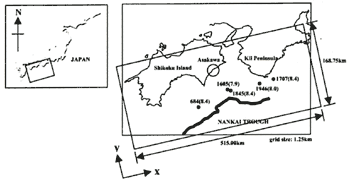|
EFFECT OF THE TSUNAMI BREAKWATER UNDER CONSTRUCTION AGAINST TSUNAMI DISASTERS
Hiroaki Sato1, Hitoshi Murakami2, Yasunori Kozuki2 and Kengo Kurata2
1 Coastal Engineering Division, River and Coastal Engineering Department
NEWJEC Inc., Osaka, JAPAN
satohr@osaka.newjec.co.jp
2Department of Ecosystem Engineering, University of Tokushima
Tokushima, Tokushima, JAPAN
ABSTRACT
Usually, the tsunami breakwater is designed based on the historical tsunami height. However, if the tsunami occurs at the some other place, tsunami height in the bay may be over allowable height. It is important to consider the various locations and magnitudes of seabed displacement. In this study, the Monte Carlo method was used for prediction of tsunami height in the bay. In the tsunami calculation it was considered the random tidal height, latitude, longitude, vertical fault deformation and calculative accuracy. They were defined as the Normal or Weibull distribution. Six cases of the different tsunami breakwater length were set, and the iterative calculations were carried out at 5,000 times for one case. The number of tsunami that is over allowable height in the bay was counted, and "the tsunami suffering probability" was defined by using them. The tsunami suffering probability enabled to estimate the length of tsunami breakwater against various tsunamis. For instance, the tsunami breakwater under construction will have no effect for decay of the tsunami. When the allowable tsunami suffering probability is fixed, the best length of the tsunami breakwater can be decided simply.
INTRODUCTION
In Japan, Nankai Trough runs from east to west of offshore Shikoku Island and
Kii peninsula (here in Nankaido), and this is an area experienced many big earthquakes. The quake registers
a magnitude of near or over 8.0. Each time, residents living near the Nankaido suffered a damage from
tsunami disasters. All these areas will be dangerous for next tsunami, because of the tsunami attacks
within about 20 minutes after the seabed displacement ( Murakami et al., 1996).
It means that the residents have hardly any time to evacuate. Thus, the government has constructed the
tsunami breakwater at these districts. The common breakwater or the seawall was designed based on the
encounter probability, for example, the wave with a return period of 50 years. The tsunami breakwater,
however, was designed based on the most dangerous tsunami in the past, because the large tsunamis rarely
occur at Nankaido. Therefore, we cannot assume the encounter probability against tsunami. Tsunami height
will change with the fault location. Supposing the same fault model of Ansei earthquake in 1854 is utilized
in the theoretical calculation, the result values maybe change according to the different set-up of the
model ( Kawata et al., 1994; Murakami et al., 1997;
Hiraishi et al., 1999; Tohiki et al., 2000).
In this study, to propose an optimum design method of tsunami breakwater the suffering probability acquired
by launching multiple is used. In order to install the probability, the Monte Carlo method was used for
the prediction of tsunami height in the bay. It was considered random tidal height, latitude, longitude,
vertical fault deformation and calculative accuracy in the tsunami calculation.
BASIC EQUATIONS AND CALCULATION DOMAIN
Basic equations
Basic numerical equations of tsunami propagation are equation (1) - equation (3). The second and third terms in the left side of equations (1) and (2) can be neglected when the water depth is over 50 meters.
where, t denotes time; g is the gravity accelerator; ζis water level lift from
still water level; h is water depyth; f is friction coefficient of ocean bottom; M and N represents the
discharge flux in x and y direction, respectively; ζis the vertical amount of seabed displacement, which
can be estimated by Manshinha-Smylie theory (1971) by fault model. Here,
ζis the water surface change by the wave. In the above equations, H and Q can be yielded as
H =h+ζ-ξ (4)
For the boundary conditions, full reflection is assumed at the landward side, while non-reflection is used at the other sides. Linear long propagating wave is assumed which fulfills equation (6).
M 2+N 2=gH・ζ 2 (6)
Calculation domain and conditions
Figure 1 shows the computation domain of the present study, which covers an area 515.00km×168.75km. The coordinate system is also illustrated in Figure 1 where the symbol "●" indicates the historical earthquake epicenters at the Nankaido offshore. In history, at the Nankaido, all serious earthquakes occurred within this area. The grid size for the numerical scheme is 12.5 m; the minimum water depth is 1.0 m; time step is chosen as 0.5 second for stability. In addition, offshore tsunami waves are calculated for three hours after the seabed displacement using a two-dimensional leapfrog method.
| (Enlarge: 22KB) |
 |
Figure 1. Calculation domain
Present situation of Asakawa town, Japan
We considered the tsunami suffering probability at Asakawa town (Fig. 1). Historically, Asakawa town frequently suffers from tsunamis; immediately, the loss of residents is very large. For instance, the Showa earthquake and tsunami in 1946 caused 66 deaths in Asakawa. While in a coastal community of Shikuku Island, the average numbers of deaths were about ten. The main reason lies in the fast arrival time (10 minutes) and high tsunami wave (5-6 m). Now, two tsunami breakwaters are under construction at the bay mouth. South side is completed, but north side is not finished yet (Fig. 2).
Figure 2. Asakawa bay
|